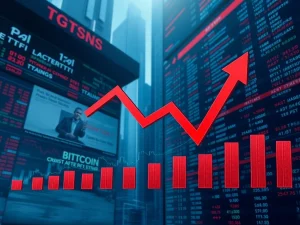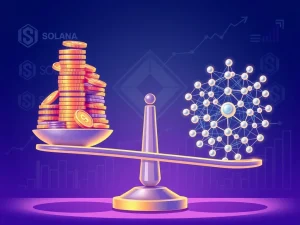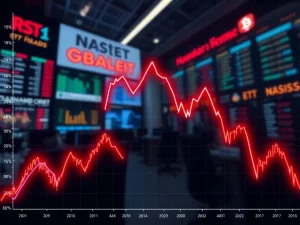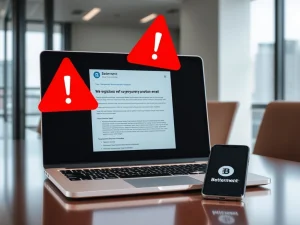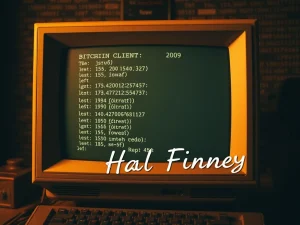Crucial Tesla Shareholders Vote Looms for xAI Investment
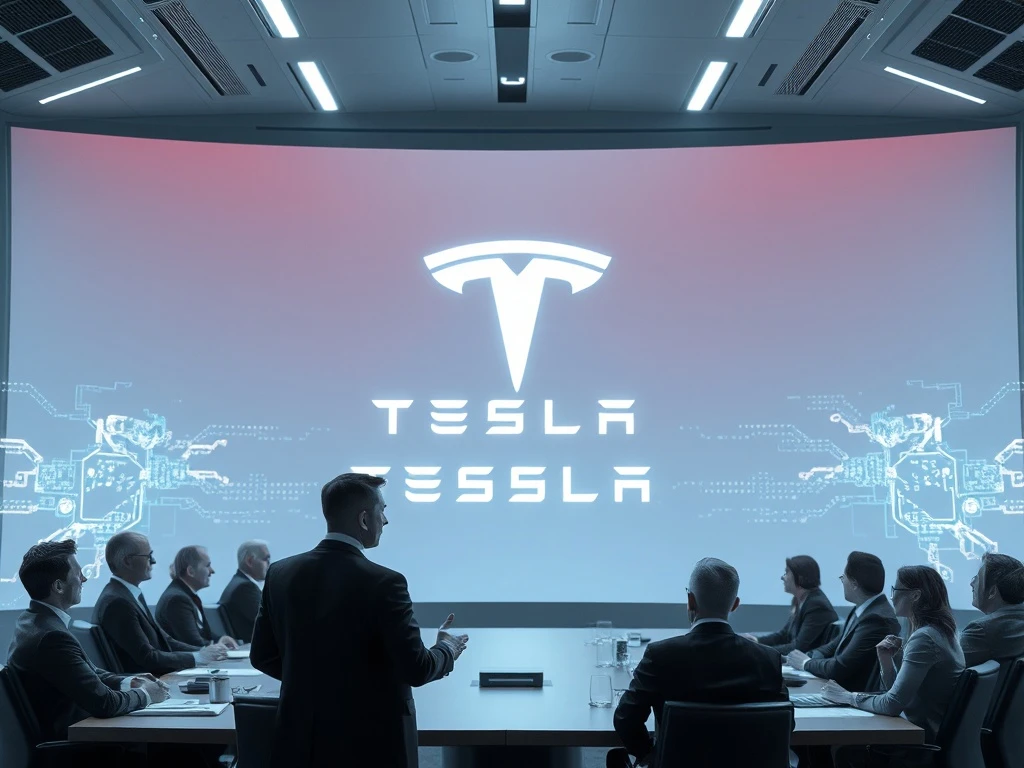
In a move that has sent ripples across the tech and investment world, Elon Musk has announced a groundbreaking decision: the fate of a potential xAI investment from Tesla Inc. (TSLA) will now rest squarely with its Tesla Shareholders. This isn’t just a procedural detail; it’s a significant shift that could redefine corporate governance, capital allocation, and the very future of AI integration within one of the world’s most influential companies. For those tracking the convergence of cutting-edge technology and market dynamics, particularly in the cryptocurrency and AI sectors, this development is nothing short of fascinating.
Why Are Tesla Shareholders Now Calling the Shots on xAI?
During Tesla’s second-quarter earnings call, Elon Musk made it unequivocally clear: “It’s not up to me.” This statement marks a pivotal moment, signaling a deliberate deferral of a high-stakes decision to the company’s investors. Historically, major investment decisions are often made by corporate leadership, but Musk’s approach emphasizes a direct democratic process for this crucial matter. Shareholder proposals will be formally accepted ahead of the annual general meeting, scheduled for November 6th.
This isn’t an entirely new playbook for Musk. Flashback to 2016, and you’ll find a similar scenario when he sought shareholder approval for Tesla’s $2.6 billion acquisition of SolarCity. While that deal faced legal challenges, it ultimately secured investor backing. This precedent suggests Musk’s belief in the power of direct shareholder mandate for significant strategic pivots. Tesla’s Chief Financial Officer, Vaibhav Taneja, reinforced this stance, indicating that the matter would be addressed through formal shareholder processes, not earnings calls.
Unpacking the Potential xAI Investment: Risks and Rewards
Launched in 2023, xAI, Musk’s artificial intelligence venture, is still carving out its niche in a fiercely competitive landscape. While it hasn’t yet achieved the widespread developer adoption or major corporate partnerships seen with rivals like OpenAI or Anthropic, its flagship product, Grok, offers a distinct “honest” and “sarcastic” chatbot experience, deeply integrated into Musk’s social media platform, X. The existing collaboration between xAI and Tesla is notable: xAI already procures energy storage systems like the Megapack from Tesla, and there are plans to embed Grok’s AI capabilities into Tesla vehicles to enhance driver and passenger experiences. This synergy is a key argument for the proposed investment.
However, the specifics of xAI’s funding strategy remain shrouded in some ambiguity. Reports from Bloomberg indicate that SpaceX, another of Musk’s ventures, has committed a substantial $2 billion to xAI in 2024. This raises pertinent questions about the necessity and justification for Tesla’s financial involvement. The xAI investment, if approved, could deepen the operational and technological ties between the two companies, aligning with Musk’s broader vision of cross-industry AI integration. Yet, the financial demands of cutting-edge AI Development are immense. xAI reportedly seeks a staggering $12 billion debt facility from Valor Equity Partners to expand its ‘Colossus 2’ data center, a facility designed to house an astonishing 550,000 Nvidia GPUs. Such figures underscore the colossal capital required to compete at the forefront of AI.
Elon Musk’s Grand Vision: Synergies or Conflicts?
Elon Musk has consistently championed the idea that Tesla shareholders should directly benefit from xAI’s growth. His rationale centers on the perceived shared leadership and significant technological synergies between the two entities. In a recent X post, he reiterated this conviction, stating, “it’s a good idea for Tesla’s shareholders to have an exposure to AI.” This perspective frames the potential investment not just as a financial transaction but as a strategic alignment designed to offer Tesla investors a stake in the burgeoning AI market, leveraging the shared intellectual capital and innovation pathways.
The vision is compelling: imagine Tesla vehicles not just as electric cars but as sophisticated, AI-powered mobile platforms, seamlessly integrated with Grok’s advanced capabilities. This could unlock new revenue streams, enhance user experience, and solidify Tesla’s position at the intersection of automotive and artificial intelligence. However, critics are quick to point out the potential for conflicts of interest, especially given Musk’s oversight of multiple high-profile ventures, including SpaceX and Neuralink. The question arises: should a publicly traded company like Tesla prioritize its CEO’s private ventures without clear, undeniable financial justification that directly benefits Tesla’s core business?
Navigating the Competitive AI Development Frontier
The field of AI Development is characterized by rapid innovation, intense competition, and enormous capital expenditure. While xAI boasts unique selling points like Grok’s distinctive personality and integration with X, it faces formidable, well-established competitors. Companies like OpenAI, with its ChatGPT, and Anthropic, with Claude, have already secured significant market share and widespread developer adoption. For xAI to truly compete, it requires substantial, sustained funding to scale its infrastructure, attract top talent, and accelerate its research and development.
xAI’s recent initiatives, such as the “Baby Grok” project, highlight its efforts to address growing public concerns about AI’s societal impact and build trust. This project aims to improve the trustworthiness and reliability of AI models, a critical aspect for long-term success and adoption. However, despite these promising initiatives, the financial specifics behind many of xAI’s operational and growth plans remain less transparent than those of its publicly traded counterparts. The shareholder vote, therefore, isn’t just about an investment; it’s about Tesla potentially entering a new, highly capital-intensive frontier, with all its inherent risks and rewards.
Corporate Governance Under the Microscope: A Test for Tesla?
The decision to put the xAI investment to a shareholder vote also thrusts Tesla’s Corporate Governance practices into the spotlight. Analysts are keenly observing how this process unfolds, particularly given the inherent risks of entangling Tesla’s substantial operational funds with xAI’s ambitious, yet unproven, endeavors. The concern is that if xAI requires continuous, significant financing, it could potentially divert resources or attention away from Tesla’s core electric vehicle and energy businesses, which themselves require massive investment for expansion and innovation.
This situation presents a delicate balancing act between Musk’s entrepreneurial drive and Tesla’s fiduciary obligations to its investors. While an informal poll conducted by Musk on X suggested a degree of public support for Tesla’s involvement in xAI, formal shareholder approval is a much more rigorous process. The outcome of this vote will undoubtedly influence investor confidence in Tesla’s leadership and its future capital allocation strategies. It’s a test of whether the company’s strategic direction will be primarily driven by a singular vision or by the collective will and financial interests of its diverse shareholder base.
In conclusion, the upcoming Tesla Shareholders vote on the potential xAI investment represents a watershed moment for both companies and the broader tech industry. It underscores Elon Musk’s unique approach to corporate strategy and challenges conventional notions of corporate governance. The decision will not only shape the financial landscape for xAI and its ambitious AI Development plans but also set a precedent for how public companies engage with their founder’s private ventures. As November 6th approaches, all eyes will be on Tesla, anticipating a vote that could profoundly impact its strategic trajectory and redefine its role in the evolving world of artificial intelligence.
Frequently Asked Questions (FAQs)
1. Why is Elon Musk deferring the xAI investment decision to Tesla shareholders?
Elon Musk stated, “It’s not up to me,” indicating a deliberate move to empower Tesla Shareholders in a high-stakes decision. This mirrors his past approach with the SolarCity acquisition, emphasizing a democratic process for significant strategic moves and aligning investor interests with potential AI growth.
2. What is xAI and what is its relationship with Tesla currently?
xAI is Elon Musk’s artificial intelligence venture, launched in 2023, known for its chatbot Grok. Currently, xAI collaborates with Tesla by purchasing Megapack energy storage systems and plans to integrate Grok’s AI capabilities into Tesla vehicles to enhance user experience.
3. What are the potential benefits for Tesla if the xAI investment is approved?
If approved, the xAI investment could offer Tesla Shareholders direct exposure to the rapidly growing AI market, deepen technological synergies between Tesla’s vehicles and xAI’s AI models, and potentially unlock new revenue streams and enhance Tesla’s competitive edge in the smart vehicle sector.
4. What are the main concerns regarding Tesla’s potential investment in xAI?
Critics raise concerns about Corporate Governance, potential conflicts of interest given Musk’s multiple ventures, and the risk of entangling Tesla’s operational funds with xAI’s capital-intensive AI Development needs. There’s also scrutiny over whether the investment provides clear financial justification for Tesla’s core business.
5. When is the shareholder vote on the xAI investment expected to take place?
Shareholder proposals will be accepted ahead of Tesla’s annual general meeting, which is scheduled for November 6th. This is when the decision regarding the potential xAI investment will be determined by the Tesla Shareholders.

